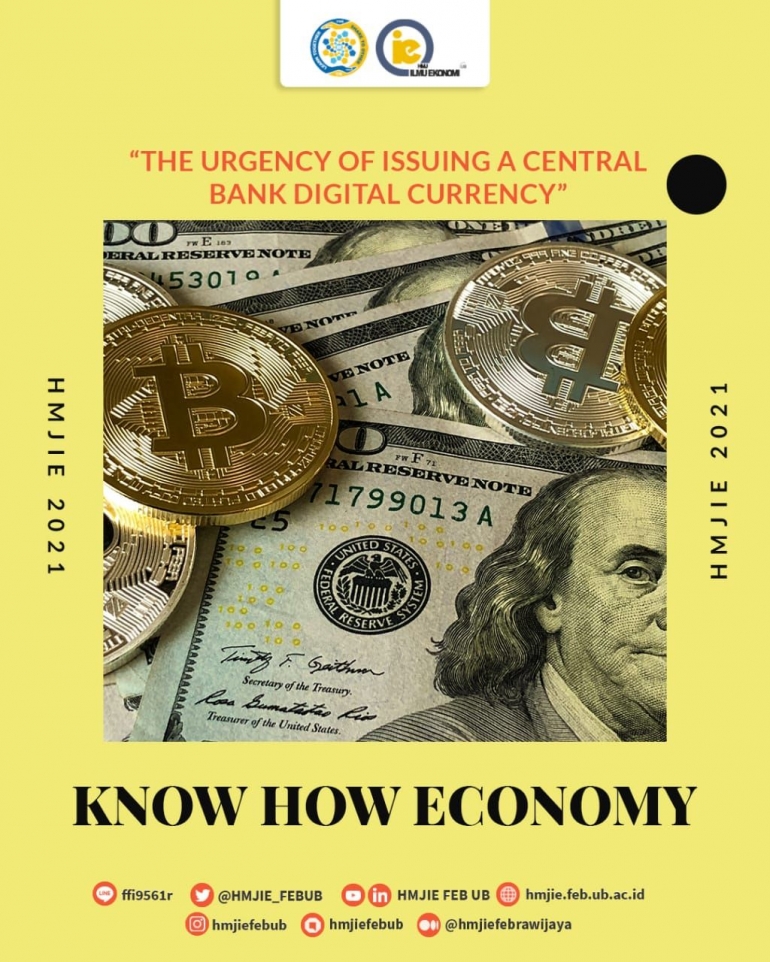In conclusion, currently, the effect that cryptocurrency in general, or stablecoins has on in particular, on monetary stability is still quite limited. This is due to the relatively small market capitalization and imperfections of these exchange commodities. With this imperfection, there is still little space for cryptocurrencies, especially stablecoins, to influence the international monetary system. However, governments, especially monetary institutions, require a deeper and periodic analysis of the dynamic development of cryptocurrency itself.
- ISSUING A CBDC
Currently the global community has carried out digital transaction activities through several media transactions, such as e-money, e-wallets, etc. Peer to peer digital transactions and categorized as micro-payments, are currently supported by several media transactions provided by several big-tech or fintech companies. So, with the existence of various digital transaction media, why do we need a currency that is standardized and supported by the stated? Isn't the provision of Qris, e-money, and other e-wallets able to meet the conditions of market demand for the current digitization of transactions in Indonesia?
To answer this question, of course we must return to the background scenario for the formation of one of the CBDCs in the world, namely China, which has already conducted a pilot project on its digital currency commodity. The Chinese economy, especially the process of cellular transactions (mobile), is controlled mostly by two big-tech big-techs, namely Ant Group with its payment system Alipay (54.7%) and Tencent with its electronic wallet, WeChat Pay (37%).
From this condition, it is feared that a monopoly process from domination of the market by the two big companies could occur. In Indonesia, one example is OVO and Gopay. Bank Indonesia noted that these two electronic wallets controlled the electronic money market share of 20% and 19%. On the other hand, the electronic money market is also dominated by several banks and other fintech companies.
With certain parties who control the digital transaction market, this can encourage a monopoly process against other market players. Based on the statement from Fabio Panetta, market domination by bigtech can make it easier for these companies to reach and obtain consumer behavior data. The data can be in the form of a database in the form of various transaction data that have been carried out by various consumers so that the company can have access to various preferences and needs of today's consumers.
As a result, these companies can provide an integrated service system through a binding of goods and services or commonly known as bundling. This can make consumers bound and have limitations in their consumption choices and preferences, and thus can threaten competition in the market against other market participants. This phenomenon can lead to a term to "the winner takes all", that is, companies that are able to survive until the end of market competition can dominate the market as a whole as the only existing producers.
On the other hand, there are several reasons for the application of CBDC as a medium for digital transactions. The central bank, as the agency responsible for monetary policy, has an obligation to maintain the stability of the currency, banking sector and the financial system as a whole. The central bank has a mandate, both explicitly and implicitly, to provide a medium of payment that is reliable, and can provide good security and efficiency.
The current development of market digitization has encouraged central banks to adapt in providing safe and trustworthy payment media for consumers as a medium of exchange value. The central bank also focuses on increasing efficiency in the monetary system through the application of CBDCs in the community. This efficiency can be achieved through several advantages possessed by CBDC. One of them is cost efficiency, simplifying accessibility, encouraging financial inclusion, facilitating cross-border payments, making it easier to implement fiscal policies through digital systems, and protecting public privacy from database management by private parties.
- CHINA CBDC AND INDONESIA BEST DESIGN CBDC'S
China is currently conducting a pilot project against its digital currency e-CNY. The CBDC model currently implemented in China uses a retail or general purpose hybrid model. The initial policy carried out by the Chinese government was to distribute e-CNY vouchers of 200 Yuan, with a total of 200,000 vouchers in the city of Shuzou, then in the city of Shenzen worth 10 million Yuan, and this year vouchers were distributed in Beijing and Chengdu. Vouchers that are distributed in the form of e-CNY, can be spent through the e-commerce platform, namely JD.com.
Then what about Indonesia? According to research published through the Bank Indonesia bulletin, the current suitable CBDC for Indonesia is CBDC which has similar characteristics to conventional cash. The nature of this CBDC is similar to the general purpose model or the retail CBDC model.
By using the Delphi-Analytics Network Process method, it shows that the current market conditions in Indonesia are guided by peer to peer transactions. Another supporting factor for the suitability of this model is that China also uses the same model and scenario, namely the retail hybrid model. This may be due to the similarities in the transaction markets in China and Indonesia. On the other hand, according to PwC, currently the fintech industry in Indonesia has a simillar process to the fintech industry in China which developed in 2013.
- CHALLENGE AND RISK







